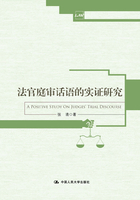
法官庭审话语的实证研究
摘要
当前,法律语言学已经成为一个全球性的热门研究领域。近年来,越来越多的学者开始关注法庭话语的动态研究,将目光放在法庭审判中的语言活动上。本研究的对象是法官在庭审中的审判话语,研究方法运用话语分析理论、言语行为理论以及语用学的目的原则等。本研究以25场真实的庭审语料为实证材料,在详细分析和描述法官庭审话语的基础上,探讨了法官庭审话语的规范化问题,以期对我国的司法改革提供一定的理论支持。
全书共分六个章节。
第一章概述了法律语言学,特别是法官语言的国内外研究状况,同时介绍了本研究的目的、方法、理论依据、语料、研究的特点及意义等。本研究采用语言学中的话语分析理论及语用学中的言语行为理论及目的原则,借用真实的庭审语料,旨在描述法官庭审话语的现状及特征,从而为拓展我国的语言学研究领域做出尝试,也在为法学理论研究提供新路径方面做出探索,同时为我国的司法审判制度改革提供一定的启示。
第二章通过运用话语分析理论(如会话结构、话轮转换、话题及话语分类等),在对9场庭审语料进行量化统计的基础上,描述分析了法官庭审话语的结构及特点,以及法官话语在整个审判活动中的地位及特征。从中我们发现法官在整个庭审话语活动中仍然掌握着最大的话语权,即便在已经改革了的刑事审判中也是如此。同时还发现,法官在刑事审判中的庭审话语以程序性话语居多;相比较而言,法官在民事、行政案件审判中实体性话语占据绝对多数,且在后者中,法官在法庭审理这个“舞台”上仍然占据着“主角”地位;而在刑事案件审判中,法官的“主角”地位已经淡化。此外,问答结构不仅是整个庭审的主要话语结构,也是由法官启动的话轮的主要结构。
第三章从言语行为理论的角度分析法官的庭审话语行为。法庭审判活动是以话语进行的,法官的庭审话语就是在实施言语行为。言语行为理论为我们分析探讨法官的言语行为提供了一种分析模式。言语行为理论从总体上研究话语的施事行为,认为说话就是做事。按照奥斯汀对施事行为的划分,法官的庭审话语就是在实施审判行为。法庭话语属于机构话语,虽然受法庭这一机构规则的严格制约,但一般言语行为原则在一定程度上仍然起作用。法官的庭审话语不仅是说话行为,同时还是施事行为和取效行为。我们从法官最后的宣判行为中的“本院认为”句式中可以清楚地看到法官庭审话语的言语行为功能。
第四章运用语用学中的目的原则来描述、揭示法官的庭审话语。目的系统论认为目的是一个有结构、有层次、有机的系统。用语用学的目的原则分析法官话语,我们可以看到法官的审判话语就是这样一个有结构、有层次的目的系统。法官的话语都是在一定目的引导下的话语活动。法官为了实现其话语目的,进而实现整个审判目的,通常会使用带有目的性很强的话语策略,如打断策略。
第五章主要探讨法官话语规范化的必要性、途径及意义。在现实审判活动中,法官不可避免地出现“语误”,即审判话语失范。但是由于法官的特殊地位及作用,法官的失范话语可能造成不公正的效果。因此要保证审判公正,就需要规范法官的审判话语。我们认为,在实行当事人主义的审判方式下,法官在庭审中要尽量退居次要地位。在总体话语量中,以说规范、说准确为前提,尽量采用程序性话语,控制实体性话语量,以真正体现法官的中立角色地位。
第六章归纳了本研究的主要内容、重要发现和可能的启示,指出了本研究的特色与创新之处,以及其中存在的不足和未来研究的设想。本研究在方法上尝试了不同的视角,是针对司法实践话语的一种语用研究,具有交叉学科的研究范式,兼具方法论及现实意义。但是由于语料的局限性,经验性描述较多而理论探讨不足,有待于今后进行更深入的理论探讨,应将法官庭审话语、司法制度及司法公正更好地结合起来进行研究。
关键词:法官 庭审话语 话语分析 言语行为 目的原则
A POSITIVE STUDY ON JUDGES’ TRIAL DISCOURSE
ABSTRACT
The study of forensic linguistics has been on the rise both at home and abroad. In China, the scholars who are engaged in the research of this field are mainly the scholars of law, Chinese language and foreign language study. Recently, many scholars begin to pay attention to the dynamic study on the trial discourse. More and more scholars are focusing on the language activities taking place in the courtroom. This paper aims at the study on the discourse features, speech acts and goal analysis of judges’ trial discourse from the perspectives of discourse analysis, speech act theory and the principle of goals together with the analysis of 25 transcripts of courtroom trials so as to give a general description of judges’ trial discourse and attempt to provide some proposals which may contribute to the normativeness of judges’ trial discourse. It is hoped that the study may give some hints to the judicial practice and judicial reforms in China.
The whole book is composed of six chapters.
As an introduction to the paper, the first chapter intends to introduce the theoretical background and the overall framework of the whole book. Firstly, it briefly examines the academic history of language and law study which proves later to have laid a solid foundation for the forensic linguistics coming into being as a formal subject, and reviews the recent developments and accomplishments of forensic linguistic studies both at home and abroad. And then it provides a survey of the present paper, including its main contents, research value and significance, and the academic theory and study methods to be employed.
Chapter Two is a quantitative description of 9 courtroom trials in terms of discourse analysis theory, such as adjacency pair, conversational structure, turn-taking, topics and classification of discourse, etc., aiming to uncover the features and status of judges’ trial discourse. We have discovered that judges still assume the supreme power in the whole trial discourse activities, and it is so even in the criminal trail after the judicial reform. However, we have also found out that the procedural discourse of judges in criminal trials takes predominance, whereas by contrast, the substantive discourse in civil and administrative trials is the dominant discourse, where judges are still playing the leading role on the trial stage. Hopefully the leading role of judges in criminal trials is diminishing. Besides, the pattern of question-response is still the major structure of the court trial, so is the judges’ discourse with other participants in the trial.
In Chapter Three, the speech act theory is adopted to analyze the judges’ trial discourse. It is obvious that the courtroom trial is conducted through discourse, in which the judges’ trial discourse is also performing speech acts. The speech act theory by Austin provides us with a pattern of analyzing judges’ trial discourse. The speech act theory deals with the illocutionary act of discourse generally, in which saying is doing. According to the distinctions of illocutionary acts by Austin, we have found that judges’ trial discourse is actually performing the trial act. The trial discourse is a kind of institutional discourse, which is restricted strictly by the rules of institutions though, and the general speech act still plays a role in it. The judges’ trial discourse is not only a locutionary act, but also an illocutionary act and perlocutionary act. By analyzingthe sentence pattern of “consideratum est per curiam” when judges pronounce a judgment, we may clearly notice the aim and functions of speech acts of judges’ trial discourse.
Chapter Four aims to employ the principle of goal analysis in pragmatics so as to describe and discover the judges’ trial discourse. According to the system of goals theory, goals are a system with the goals, and in order to realize his/her discourse goals, so as to realize the aim of the whole trial, the judge may have adopted many goal-oriented discourse strategies, such as interruptions, which are closely related with power.
In Chapter Five, it is devoted to the standardization of judges’ trial discourse. In real life trial practice, it is unavoidable that judges may make some errors in their trial discourse. However, due to their special status and positions, such discourse errors may cause disastrous results. Therefore, in order to guarantee a just trial, it is a must for judges to make their trial discourse normative. Under the adversarial system of trial, judges should remain as passive in the trial as they can. In terms of discourse, under the premises of speaking within norms and accurately, judges should produce more procedural discourse rather than substantive one, which is in conformity with the spirits of procedure laws.
Finally, the last chapter, Chapter Six, as the conclusion part of the book, summarizes the main points and important findings of this study. In addition, it highlights its significance, makes some explanations over its limits and shortcomings, and indicates the possible improvements and further researches in this field in the future.
KEY WORDS: judge, trial discourse, discourse analysis, speech act, goal principle